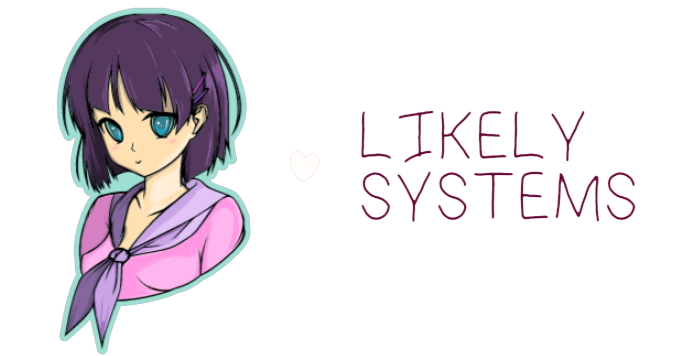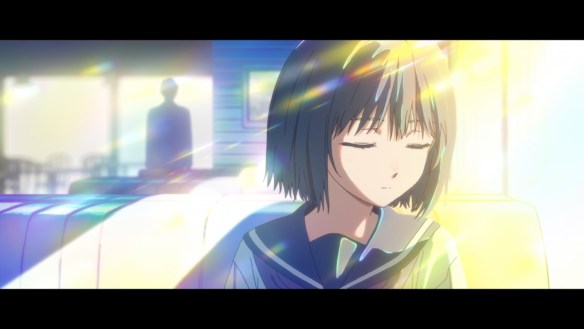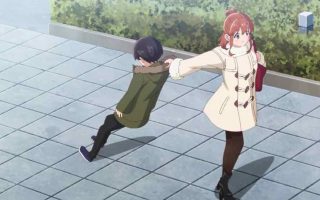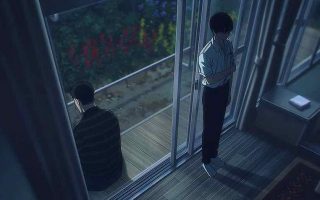Hello folks, and welcome back to Wrong Every Time. Today I thought we’d check back in on the heroes of Shoushimin Series, though I’m sure they themselves would shirk at such an appellation. Claiming a mutual dedication to the pursuit of normalcy, Osanai and Jogoro are determined to not make any waves, with Jogoro asserting that even his acquaintanceship with Kengo is merely an affirmation of their arcane value system. But normal people do not prize normalcy; in their very preoccupation with assuming this camouflage, our leads reveal themselves as distinctive, self-denying oddities.
Our last episode revealed just how much of a mask Jogoro has seemingly adopted, as Kengo grilled him on his transformation from an inquisitive, conceited know-it-all to a self-effacing cipher. Jogoro claims there was no impetus behind this transformation beyond the natural softening of age, and yet fragments of his old self are perpetually leaking through, so much so that even Osanai has preemptively forgiven him for “returning to how you were when I first met you.” So we are left once again with Kengo’s unanswered question, as to what Jogoro is attempting to achieve through seeking “normalcy,” or rather what he is trying to avoid by denying his talents. For Oreki, the fear of embracing his talent stemmed from a fundamental lack of self-worth, as acknowledging them carried an implicit responsibility to make use of them – a fear he would ultimately overcome through his desire to be a partner worthy of standing at Chitanda’s side. Here, Osanai is performing the opposite role, validating Jogoro’s refusal to embrace his full self. But what is it that makes Jogoro so afraid of his own talent, and why is Osanai so attached to this project as well? The mysteries keep stacking as we return to Shoushimin Series!
Episode 3
“Humpty Dumpty.” A title that emphasizes the limitations of intellect and the inevitability of irreparable damage. Jogoro could be framed as either the egg or the king’s men – someone who placed himself in a position courting self-destruction, or the one who was incapable of saving another from their hubris or ill fortune. A potential clue to the event Kengo sought, the failure or disappointment that prompted him to avoid showing off his talents
This show is a pretty stark example of the cruciality of building trust with your audience through formal excellence. Many stories conceal key character motivation as a hook to provoke audience curiosity, and I generally see this trick as self-destructive; by making the characters themselves the mystery, the author ensures the audience can’t foster a meaningful, sympathetic attachment to the cast. Shoushimin Series is able to get away with this largely because the solidity of its craft offers a reason to trust the author’s intentions; even if I wasn’t familiar with Hyouka, both Yonezawa’s writing and Kanbe’s direction seem deliberate enough to inspire confidence, which in turn makes me inclined to offer them this extended stretch of rope
And of course, the very fact that the show is so well-executed on a visual and script level means any ostensible hook has to carry less weight; when the journey is an aesthetic pleasure, the destination is less essential as motivation. I’m currently reading Titus Groan, which moves at a glacial pace relative to modern narrative convention, but which is such an accomplished love letter to language itself that the pacing is irrelevant
Love the distinct texturing of the sunlight in this OP cut panning past Osanai. The general restraint of the aesthetic allows these moments of dazzling color to shine all the brighter, emphasizing the divide between the two realities our leads inhabit
Snacks are Osanai’s indulgence, and one of the key motifs of this OP. They’ve also played divergent roles throughout this episode so far, with Kengo’s messy obliteration of his cake seemingly linking desserts to honest engagement with the world
Total silence and subdued gray tones lead us back into school, where Osanai is deliberating over a test. Suddenly, a crash draws her attention to the hall outside
As the OP makes clear, Osanai’s eyes are a crucial portal, their vivid colors demonstrating the alternate self she keeps locked inside. An echo of Chitanda’s captivating eyes, but here intentionally caged, generally kept half-closed unless she is startled into engagement
Osanai calls Jogoro at home, telling him she needs his help. She apparently has as much trouble denying her curiosity as he does
“Humpty Dumpty? I thought you said you were staying away from there.” More rules and code words gesturing towards their strange, labored philosophy
Ah, Humpty Dumpty is actually a restaurant. Again, tethering the indulgence of sweets to the indulgence of fully engaging with the world
“Is Osanai going to stress-eat again?” I love how frank and comfortable they are with each other
Oh god, it’s an all-you-can-eat cake place
Simple tricks of blocking divide them in the frame, emphasizing their current disconnect. The cakes also tell a story – Osanai is currently indulging in a curiosity that they see as reflective of their “abnormal” nature, while Jogoro and his single cake are offering a fine performance of reserved, indifferent normalcy
Jogoro asks a perfectly normal question about the tests, which startles Osanai a bit, as she’s already wandered off script
The crashing of the vase disturbed her focus on the test. She’s walking around her actual question, and you can sense her frustration slipping through her poise. We’ve basically become acquainted with Jogoro’s suppressed self, but I am extremely curious about Osanai’s other side
Jogoro leaves to “recover his phone.” The camera lingers over his uneaten cake, but Jogoro is embracing his own form of indulgence – through the excuse of retrieving his phone, he is able to indulge their mutual curiosity without technically breaking the rules of normalcy
Thus the case is presented: a vase was smashed in the cleaning cupboard during the exams, at a time when no one could have directly interacted with it
The storyboarding does an excellent job of presenting the school as a labyrinth brimming with secret corners and potential clues, frequently setting Jogoro in the corner of intersecting angles in the environment
Osanai’s posture remains reserved as he returns, with only those brilliant eyes challenging Jogoro and demanding an answer
The first question resolved is obviously the motive; calling everyone’s attention mid-exam could easily be exploited to cheat in some way
Jogoro deduces it’s one of the classic locked room solutions – the culprit used ice within the vase to hold it steady for a given amount of time until enough ice melted for it to fall free. Ice’s fickle, ultimately vanishing nature makes it useful for mystery situations when some object needs to have disappeared (like when it’s used as a murder weapon), and its slow decay allows for culprits to set natural timers on their schemes that can temporally divorce them from the scene of the crime
It feels like it would be a lot more work to set up this scheme than to just study a bit more, though. Thus the whole gambit implies a certain “love of the game” on the part of the culprit, where the trick was more important than the result
Jogoro also suspects a secondary motivation, particularly since the culprit was apparently “careless” enough to leave their cheat sheet as evidence. Someone who conceived of destroying the other evidence via ice would not leave such an obvious source of incrimination – meaning they likely wanted that evidence to be discovered, perhaps to implicate their actual target
It is Osanai who proposes this answer, not Jogoro. He’s less willing to immediately assume such a negative conclusion
“A broken vase won’t fix itself.” Jogoro’s statement could easily apply to his and Osanai’s efforts to “fix” each other
Afterwards, Osanai sees Sakagami riding past on her stolen bike. Her eyes blaze; she can’t stay ordinary when so provoked
Osanai is once again called to the guidance counselor’s office, and learns her bike has been discovered, although the cop who found it accidentally ran it over. Her anger is also drawing her further into the overall mystery; apparently a student named Iokibe had their ID documents stolen in a potentially related incident
Love this cut to the “scene of the crime,” like the bike is a murder victim laid out in white tape
“Sakagami probably stepped on this part.” Osanai’s bitterness is clear as the camera deliberately avoids her eyes
“What do you think happened yesterday?” Once again, her engagement with this curiosity is linked with the indulgence of sweets, as she munches on a lollipop
Interestingly, when playing back his interpretation of what happened, Jogoro casts himself in the role of Sakagami
“What business could he possibly have here on the outskirts of town?” “Stay calm, Osanai-san.” Quite enjoying seeing Osanai drawn towards “abnormal” engagement in the way Jogoro was previously, and what that’s revealing about the tempestuous personality she keeps locked inside. Jogoro is apparently secretly a know-it-all – Osanai is clearly something a bit more violent
Jogoro’s process of deduction is pleasant to witness; he’s not making any big leaps in reasoning this time, just ruling out possibilities that contradict one or another known fact of the case
Osanai plans a stakeout, seeing if Sakagami will show up at the same time as yesterday
A bus to the local driving school passes by, offering an easy answer to both where Sakagami was going and why he was in such a rush
“Which is why he threw away the bike he stole from me.” Once again, we are not allowed to see Osanai’s eyes when she leans most heavily into her secret bitterness
“I was hoping for a peaceful school life, but I’ve already been treated like a thief.” Her rage quietly boils over as Jogoro stares at her back. And when she turns, the whole world is lit in the furious red light of her eyes as she declares “I need to make him pay.” Yeah, her hidden self is much more intense than Jogoro’s
The scene jumps to the bridge where they always declare their pledges of normalcy. They are now atop it rather than hidden in its shadows, as Osanai announces her intent to make the crossing, to embrace her true violent self
“We won’t be ordinary people if we don’t just let these things happen.” Sorry Jogoro, but Osanai is already halfway across the being nice/going apeshit Rubicon
Lovely compositions here, embracing the red-dominated color scheme and contrasting it with the harsh black bars of the bridge, creating a sense of entrapment that is lent further urgency by the setting sun. Osanai is a caged animal struggling against her nature, like a werewolf fleeing the moon’s rise
“Why don’t we say that the most important thing to ordinary people is making sure we continue to have what we have?” Her smile is so menacing, precisely because it’s so perfectly tuned to appear disarming
And then she turns, the mask slipping as she’s distracted, a new clue on the horizon. She is not particularly good at being normal
Jogoro calls in Kengo, ostensibly to act as Osanai’s bodyguard, though I suspect it’s to keep her from doing anything too drastic to Sakagami. After that last scene, I could see her pushing him off a bridge with that same false smile on
“I don’t like these situations anymore.” Now it’s Jogoro’s turn to hide his eyes, as he admits to genuine frustration that Osanai is forcing him back towards his old self
“I realized inserting myself into problems that people are working really hard on, then proceeding to solve them isn’t really welcomed.” Excellent character acting as Jogoro finally admits to some version of the events that prompted him to change his personality. Other people don’t like to have the things they genuinely care about be treated as pure intellectual exercises, nor do they like having some know-it-all “solve” their emotional crises. Jogoro learned to be pleasant and distant to avoid prompting this friction – I imagine he’s been called cold and inhuman in the past, and those accusations still burn at him
“I’ve been seeing the truth of every situation before everyone else since elementary school.” And all it has won him is contempt and isolation
“I have no interest in continuing a friendship with this current petty, sly version of you.” Nonetheless, Kengo at least prefers the real him
“You were an asshole before. But I didn’t hate that.” Kengo swiftly rising in my estimation
With Kengo’s assurance that he actually likes the real Jogoro, light at last floods the room, the sun piercing through clouds. An echo of Oreki’s trip home from Chitanda’s estate, when he is first called into the sunlight
And Done
Hell yes, what an episode! After two excursions spent clinging to their curious pursuit of normalcy, both Jogoro and Osanai revealed much of their true nature this episode, as well as why each of them might have chosen to abandon sincerity. Though he claimed there was no specific incident that changed him, Jogoro’s confession here made it clear that the weight of his intelligence had thoroughly isolated him, prompting others to reject him as a smug, unfeeling machine. Meanwhile, it seems that Osanai actually feels too much when she is unleashed, possessing a bitterness, vengeful streak, and profound intensity of emotion that could easily lead her to violent, antisocial destinations. It’s been a delight getting to know these two, and I’m even more excited to see what they might do now that their chains have slackened, and each has been given the leeway necessary to embrace their darker shadows. Sakagami has no idea what’s coming for him!
This article was made possible by reader support. Thank you all for all that you do.




